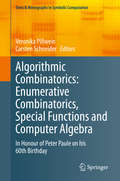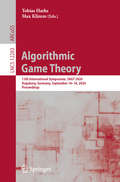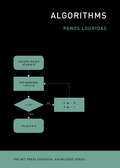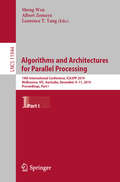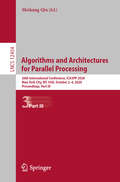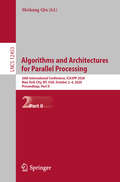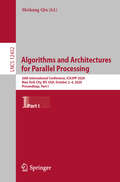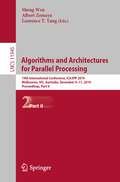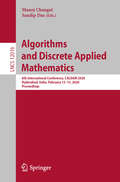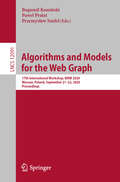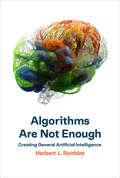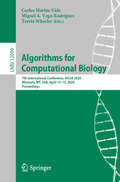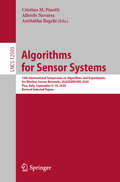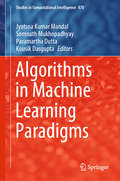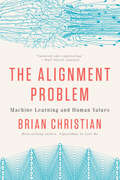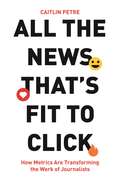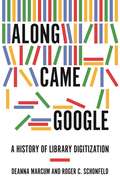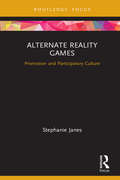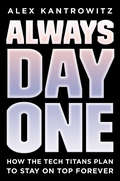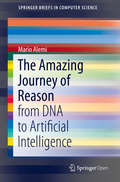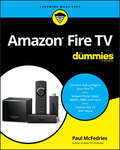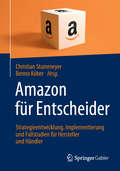- Table View
- List View
Algorithmic Combinatorics: In Honour of Peter Paule on his 60th Birthday (Texts & Monographs in Symbolic Computation)
by Veronika Pillwein Carsten SchneiderThe book is centered around the research areas of combinatorics, special functions, and computer algebra. What these research fields share is that many of their outstanding results do not only have applications in Mathematics, but also other disciplines, such as computer science, physics, chemistry, etc. A particular charm of these areas is how they interact and influence one another. For instance, combinatorial or special functions' techniques have motivated the development of new symbolic algorithms. In particular, first proofs of challenging problems in combinatorics and special functions were derived by making essential use of computer algebra. This book addresses these interdisciplinary aspects. Algorithmic aspects are emphasized and the corresponding software packages for concrete problem solving are introduced. Readers will range from graduate students, researchers to practitioners who are interested in solving concrete problems within mathematics and other research disciplines.
Algorithmic Game Theory: 13th International Symposium, SAGT 2020, Augsburg, Germany, September 16–18, 2020, Proceedings (Lecture Notes in Computer Science #12283)
by Tobias Harks Max KlimmThis book constitutes the refereed proceedings of the 13th International Symposium on Algorithmic Game Theory, SAGT 2020, held in Augsburg, Germany, in September 2020.* The 21 full papers presented together with 3 abstract papers were carefully reviewed and selected from 53 submissions. The papers are organized in topical sections named: auctions and mechanism design, congestion games and flows over time, markets and matchings, scheduling and games on graphs, and social choice and cooperative games. * The conference was held virtually due to the COVID-19 pandemic.
Algorithms: A Beginner's Guide (The MIT Press Essential Knowledge series)
by Panos LouridasIn the tradition of Real World Algorithms: A Beginner's Guide, Panos Louridas is back to introduce algorithms in an accessible manner, utilizing various examples to explain not just what algorithms are but how they work.Digital technology runs on algorithms, sets of instructions that describe how to do something efficiently. Application areas range from search engines to tournament scheduling, DNA sequencing, and machine learning. Arguing that every educated person today needs to have some understanding of algorithms and what they do, in this volume in the MIT Press Essential Knowledge series, Panos Louridas offers an introduction to algorithms that is accessible to the nonspecialist reader. Louridas explains not just what algorithms are but also how they work, offering a wide range of examples and keeping mathematics to a minimum.
Algorithms and Architectures for Parallel Processing: 19th International Conference, ICA3PP 2019, Melbourne, VIC, Australia, December 9–11, 2019, Proceedings, Part I (Lecture Notes in Computer Science #11944)
by Albert Zomaya Laurence T. Yang Sheng WenThe two-volume set LNCS 11944-11945 constitutes the proceedings of the 19th International Conference on Algorithms and Architectures for Parallel Processing, ICA3PP 2019, held in Melbourne, Australia, in December 2019. The 73 full and 29 short papers presented were carefully reviewed and selected from 251 submissions. The papers are organized in topical sections on: Parallel and Distributed Architectures, Software Systems and Programming Models, Distributed and Parallel and Network-based Computing, Big Data and its Applications, Distributed and Parallel Algorithms, Applications of Distributed and Parallel Computing, Service Dependability and Security, IoT and CPS Computing, Performance Modelling and Evaluation.
Algorithms and Architectures for Parallel Processing: 20th International Conference, ICA3PP 2020, New York City, NY, USA, October 2–4, 2020, Proceedings, Part III (Lecture Notes in Computer Science #12454)
by Meikang QiuThis three-volume set LNCS 12452, 12453, and 12454 constitutes the proceedings of the 20th International Conference on Algorithms and Architectures for Parallel Processing, ICA3PP 2020, in New York City, NY, USA, in October 2020. The total of 142 full papers and 5 short papers included in this proceedings volumes was carefully reviewed and selected from 495 submissions. ICA3PP is covering the many dimensions of parallel algorithms and architectures, encompassing fundamental theoretical approaches, practical experimental projects, and commercial components and systems. As applications of computing systems have permeated in every aspects of daily life, the power of computing system has become increasingly critical. This conference provides a forum for academics and practitioners from countries around the world to exchange ideas for improving the efficiency, performance, reliability, security and interoperability of computing systems and applications. ICA3PP 2020 focus on two broad areas of parallel and distributed computing, i.e. architectures, algorithms and networks, and systems and applications.
Algorithms and Architectures for Parallel Processing: 20th International Conference, ICA3PP 2020, New York City, NY, USA, October 2–4, 2020, Proceedings, Part II (Lecture Notes in Computer Science #12453)
by Meikang QiuThis three-volume set LNCS 12452, 12453, and 12454 constitutes the proceedings of the 20th International Conference on Algorithms and Architectures for Parallel Processing, ICA3PP 2020, in New York City, NY, USA, in October 2020. The total of 142 full papers and 5 short papers included in this proceedings volumes was carefully reviewed and selected from 495 submissions. ICA3PP is covering the many dimensions of parallel algorithms and architectures, encompassing fundamental theoretical approaches, practical experimental projects, and commercial components and systems. As applications of computing systems have permeated in every aspects of daily life, the power of computing system has become increasingly critical. This conference provides a forum for academics and practitioners from countries around the world to exchange ideas for improving the efficiency, performance, reliability, security and interoperability of computing systems and applications. ICA3PP 2020 focus on two broad areas of parallel and distributed computing, i.e. architectures, algorithms and networks, and systems and applications.
Algorithms and Architectures for Parallel Processing: 20th International Conference, ICA3PP 2020, New York City, NY, USA, October 2–4, 2020, Proceedings, Part I (Lecture Notes in Computer Science #12452)
by Meikang QiuThis three-volume set LNCS 12452, 12453, and 12454 constitutes the proceedings of the 20th International Conference on Algorithms and Architectures for Parallel Processing, ICA3PP 2020, in New York City, NY, USA, in October 2020.The total of 142 full papers and 5 short papers included in this proceedings volumes was carefully reviewed and selected from 495 submissions. ICA3PP is covering the many dimensions of parallel algorithms and architectures, encompassing fundamental theoretical approaches, practical experimental projects, and commercial components and systems. As applications of computing systems have permeated in every aspects of daily life, the power of computing system has become increasingly critical. This conference provides a forum for academics and practitioners from countries around the world to exchange ideas for improving the efficiency, performance, reliability, security and interoperability of computing systems and applications. ICA3PP 2020 focus on two broad areas of parallel and distributed computing, i.e. architectures, algorithms and networks, and systems and applications.
Algorithms and Architectures for Parallel Processing: 19th International Conference, ICA3PP 2019, Melbourne, VIC, Australia, December 9–11, 2019, Proceedings, Part II (Lecture Notes in Computer Science #11945)
by Albert Zomaya Laurence T. Yang Sheng WenThe two-volume set LNCS 11944-11945 constitutes the proceedings of the 19th International Conference on Algorithms and Architectures for Parallel Processing, ICA3PP 2019, held in Melbourne, Australia, in December 2019. The 73 full and 29 short papers presented were carefully reviewed and selected from 251 submissions. The papers are organized in topical sections on: Parallel and Distributed Architectures, Software Systems and Programming Models, Distributed and Parallel and Network-based Computing, Big Data and its Applications, Distributed and Parallel Algorithms, Applications of Distributed and Parallel Computing, Service Dependability and Security, IoT and CPS Computing, Performance Modelling and Evaluation.
Algorithms and Discrete Applied Mathematics: 6th International Conference, CALDAM 2020, Hyderabad, India, February 13–15, 2020, Proceedings (Lecture Notes in Computer Science #12016)
by Manoj Changat Sandip DasThis book constitutes the proceedings of the 6th International Conference on Algorithms and Discrete Applied Mathematics, CALDAM 2020, held in Hyderabad, India, in February 2020. The 38 papers presented together with 2 invited talks in this volume were carefully reviewed and selected from 102 submissions. The papers are organized in topical sections on graph algorithms, graph theory, combinatorial optimization, distributed algorithms, combinatorial algorithms, and computational complexity.
Algorithms and Models for the Web Graph: 17th International Workshop, WAW 2020, Warsaw, Poland, September 21–22, 2020, Proceedings (Lecture Notes in Computer Science #12091)
by Bogumił Kamiński Paweł Prałat Przemysław SzufelThis book constitutes the proceedings of the 17th International Workshop on Algorithms and Models for the Web Graph, WAW 2020, held in Warsaw, Poland, in September 2020. The 12 full papers presented in this volume were carefully reviewed and selected from 19 submissions. The aim of the workshop was to further the understanding of graphs that arise from the Web and various user activities on the Web, and stimulate the development of high-performance algorithms and applications that exploit these graphs.Due to the corona pandemic the conference was postponed from June 2020 to September 2020.
Algorithms Are Not Enough: Creating General Artificial Intelligence
by Herbert L. RoitblatWhy a new approach is needed in the quest for general artificial intelligence.Since the inception of artificial intelligence, we have been warned about the imminent arrival of computational systems that can replicate human thought processes. Before we know it, computers will become so intelligent that humans will be lucky to kept as pets. And yet, although artificial intelligence has become increasingly sophisticated--with such achievements as driverless cars and humanless chess-playing--computer science has not yet created general artificial intelligence. In Algorithms Are Not Enough, Herbert Roitblat explains how artificial general intelligence may be possible and why a robopocalypse is neither imminent, nor likely.
Algorithms for Computational Biology: 7th International Conference, AlCoB 2020, Missoula, MT, USA, April 13–15, 2020, Proceedings (Lecture Notes in Computer Science #12099)
by Carlos Martín-Vide Miguel A. Vega-Rodríguez Travis WheelerThis book constitutes the proceedings of the 7th International Conference on Algorithms for Computational Biology, AlCoB 2020, was planned to be held in Missoula, MT, USA in April 2020. Due to the corona pandemic the conference was postponed to be held together with AlCoB 2021.The 15 full papers included in this volume were carefully reviewed and selected from 24 submissions. They were organized in topical sections on genomics, phylogenetics, and RNA-Seq and other biological processes.
Algorithms for Sensor Systems: 16th International Symposium on Algorithms and Experiments for Wireless Sensor Networks, ALGOSENSORS 2020, Pisa, Italy, September 9–10, 2020, Revised Selected Papers (Lecture Notes in Computer Science #12503)
by Cristina M. Pinotti Alfredo Navarra Amitabha BagchiThis book constitutes revised selected papers from the 16th International Symposium on Algorithms and Experiments for Wireless Sensor Networks, ALGOSENSORS 2020, held in Pisa, Italy*, in September 2020.The 12 full papers presented in this volume were carefully reviewed and selected from 27 submissions. ALGOSENSORS is an international symposium dedicated to the algorithmic aspects of wireless networks.*The conference was held virtually due to the COVID-19 pandemic.
Algorithms in Machine Learning Paradigms (Studies in Computational Intelligence #870)
by Jyotsna Kumar Mandal Somnath Mukhopadhyay Paramartha Dutta Kousik DasguptaThis book presents studies involving algorithms in the machine learning paradigms. It discusses a variety of learning problems with diverse applications, including prediction, concept learning, explanation-based learning, case-based (exemplar-based) learning, statistical rule-based learning, feature extraction-based learning, optimization-based learning, quantum-inspired learning, multi-criteria-based learning and hybrid intelligence-based learning.
The Alignment Problem: Machine Learning And Human Values
by Brian ChristianA jaw-dropping exploration of everything that goes wrong when we build AI systems and the movement to fix them. Today’s “machine-learning” systems, trained by data, are so effective that we’ve invited them to see and hear for us—and to make decisions on our behalf. But alarm bells are ringing. Recent years have seen an eruption of concern as the field of machine learning advances. When the systems we attempt to teach will not, in the end, do what we want or what we expect, ethical and potentially existential risks emerge. Researchers call this the alignment problem. Systems cull résumés until, years later, we discover that they have inherent gender biases. Algorithms decide bail and parole—and appear to assess Black and White defendants differently. We can no longer assume that our mortgage application, or even our medical tests, will be seen by human eyes. And as autonomous vehicles share our streets, we are increasingly putting our lives in their hands. The mathematical and computational models driving these changes range in complexity from something that can fit on a spreadsheet to a complex system that might credibly be called “artificial intelligence.” They are steadily replacing both human judgment and explicitly programmed software. In best-selling author Brian Christian’s riveting account, we meet the alignment problem’s “first-responders,” and learn their ambitious plan to solve it before our hands are completely off the wheel. In a masterful blend of history and on-the ground reporting, Christian traces the explosive growth in the field of machine learning and surveys its current, sprawling frontier. Readers encounter a discipline finding its legs amid exhilarating and sometimes terrifying progress. Whether they—and we—succeed or fail in solving the alignment problem will be a defining human story. The Alignment Problem offers an unflinching reckoning with humanity’s biases and blind spots, our own unstated assumptions and often contradictory goals. A dazzlingly interdisciplinary work, it takes a hard look not only at our technology but at our culture—and finds a story by turns harrowing and hopeful.
All the News That’s Fit to Click: How Metrics Are Transforming the Work of Journalists
by Caitlin PetreFrom the New York Times to Gawker, a behind-the-scenes look at how performance analytics are transforming journalism today—and how they might remake other professions tomorrowJournalists today are inundated with data about which stories attract the most clicks, likes, comments, and shares. These metrics influence what stories are written, how news is promoted, and even which journalists get hired and fired. Do metrics make journalists more accountable to the public? Or are these data tools the contemporary equivalent of a stopwatch wielded by a factory boss, worsening newsroom working conditions and journalism quality? In All the News That's Fit to Click, Caitlin Petre takes readers behind the scenes at the New York Times, Gawker, and the prominent news analytics company Chartbeat to explore how performance metrics are transforming the work of journalism.Petre describes how digital metrics are a powerful but insidious new form of managerial surveillance and discipline. Real-time analytics tools are designed to win the trust and loyalty of wary journalists by mimicking key features of addictive games, including immersive displays, instant feedback, and constantly updated “scores” and rankings. Many journalists get hooked on metrics—and pressure themselves to work ever harder to boost their numbers.Yet this is not a simple story of managerial domination. Contrary to the typical perception of metrics as inevitably disempowering, Petre shows how some journalists leverage metrics to their advantage, using them to advocate for their professional worth and autonomy.An eye-opening account of data-driven journalism, All the News That's Fit to Click is also an important preview of how the metrics revolution may transform other professions.
Along Came Google: A History of Library Digitization
by Deanna Marcum Roger C. SchonfeldAn incisive history of the controversial Google Books project and the ongoing quest for a universal digital libraryLibraries have long talked about providing comprehensive access to information for everyone. But when Google announced in 2004 that it planned to digitize books to make the world's knowledge accessible to all, questions were raised about the roles and responsibilities of libraries, the rights of authors and publishers, and whether a powerful corporation should be the conveyor of such a fundamental public good. Along Came Google traces the history of Google's book digitization project and its implications for us today.Deanna Marcum and Roger Schonfeld draw on in-depth interviews with those who both embraced and resisted Google's plans, from librarians and technologists to university leaders, tech executives, and the heads of leading publishing houses. They look at earlier digital initiatives to provide open access to knowledge, and describe how Google founders Sergey Brin and Larry Page made the case for a universal digital library and drew on their company's considerable financial resources to make it a reality. Marcum and Schonfeld examine how librarians and scholars organized a legal response to Google, and reveal the missed opportunities when a settlement with the tech giant failed.Along Came Google sheds light on the transformational effects of the Google Books project on scholarship and discusses how we can continue to think imaginatively and collaboratively about expanding the digital availability of knowledge.
Alternate Reality Games: Promotion and Participatory Culture (Routledge Critical Advertising Studies)
by Stephanie JanesUsing textual analysis, interviews with game designers, audience surveys, and close analysis of player forum discussion, this book examines the unique nature of the producer/consumer relationship within promotional Alternate Reality Games (ARGs). Historically, ARGs are rooted in advertising as much as they are in narrative storytelling. As designers often have to respond to player actions as the game progresses, players can have an impact on the storyline, on character behaviour, and potentially on the final resolution of the narrative. This book explores how both media consumers and producers are responding to this new reconfiguration of the producer/consumer/prosumer dynamic in order to better understand the diverse advertising experiences available to media audiences today. With a focus on participatory culture and the political economy of promotional communications, this in-depth analysis of ARGs will appeal to academics and researchers in the fields of games, film, advertising, and media and cultural studies.
Always Day One: How the Tech Titans Plan to Stay on Top Forever
by Alex KantrowitzAn acclaimed tech reporter reveals the inner workings of Amazon, Facebook, Google, Apple, and Microsoft, showing how to compete with the tech titans using their own playbook.At Amazon, "Day One" is code for inventing like a startup, with little regard for legacy. Day Two is, in Jeff Bezos's own words, "stasis, followed by irrelevance, followed by excruciating, painful decline, followed by death."Most companies today are set up for Day Two. They build advantages and defend them fiercely, rather than invent the future. But Amazon and fellow tech titans Facebook, Google, and Microsoft are operating in Day One: they prioritize reinvention over tradition and collaboration over ownership. Through 130 interviews with insiders, from Mark Zuckerberg to hourly workers, Always Day One reveals the tech giants' blueprint for sustainable success in a business world where no advantage is safe. Companies today can spin up new products at record speed -- thanks to artificial intelligence and cloud computing -- and those who stand still will be picked apart. The tech giants remain dominant because they've built cultures that spark continual reinvention. It might sound radical, but those who don't act like it's always day one do so at their own peril. Kantrowitz uncovers the engine propelling the tech giants' continued dominance at a stage when most big companies begin to decline. And he shows the way forward for everyone who wants to compete with--and beat--the titans.
The Amazing Journey of Reason: from DNA to Artificial Intelligence (SpringerBriefs in Computer Science)
by Mario AlemiThis Open Access book explores questions such as why and how did the first biological cells appear? And then complex organisms, brains, societies and –now– connected human societies? Physicists have good models for describing the evolution of the universe since the Big Bang, but can we apply the same concepts to the evolution of aggregated matter –living matter included? The Amazing Journey analyzes the latest results in chemistry, biology, neuroscience, anthropology and sociology under the light of the evolution of intelligence, seen as the ability of processing information. The main strength of this book is using just two concepts used in physics –information and energy– to explain: The emergence and evolution of life: procaryotes, eukaryotes and complex organismsThe emergence and evolution of the brainThe emergence and evolution of societies (human and not)Possible evolution of our "internet society" and the role that Artificial Intelligence is playing
The Amazing World of Quantum Computing (Undergraduate Lecture Notes in Physics)
by Rajendra K. BeraThis book discusses the application of quantum mechanics to computing. It explains the fundamental concepts of quantum mechanics and then goes on to discuss various elements of mathematics required for quantum computing. Quantum cryptography, waves and Fourier analysis, measuring quantum systems, comparison to classical mechanics, quantum gates, and important algorithms in quantum computing are among the topics covered.The book offers a valuable resource for graduate and senior undergraduate students in STEM (science, technology, engineering, and mathematics) fields with an interest in designing quantum algorithms. Readers are expected to have a firm grasp of linear algebra and some familiarity with Fourier analysis.
Amazon FBA: Guía Para Principiantes
by Adidas WilsonCómo funciona: Buscas productos y los envías a Amazon. Ellos, a su vez, almacenan los productos en sus almacenes. Los productos son inventariados y luego clasificados. Si un artículo se daña en el almacén, Amazon te pagará el precio completo. Cuando un comprador pide su producto en Amazon, la transacción será manejada por Amazon (el proceso es automatizado). Amazon empaqueta el artículo y lo envía a su cliente. También hacen un seguimiento después de que el producto ha sido entregado para asegurarse de que el cliente esté satisfecho.
Amazon FBA Guida per principianti
by Adidas WilsonFBA è l'acronimo di Fulfilled di Amazon. Quando entri nel programma Amazon FBA, tutto il duro lavoro viene svolto da Amazon. Come funziona: fornisci prodotti e li invii ad Amazon. A loro volta, immagazzinano i prodotti nei loro magazzini. I prodotti vengono immagazzinati e ordinati. Se un articolo si danneggia, Amazon ti pagherà l'intero prezzo. Quando un acquirente ordina il tuo prodotto su Amazon, la transazione verrà gestita da Amazon (il processo è automatizzato). Amazon confeziona l'articolo e lo spedisce al tuo cliente. Sono responsabili inoltre delle fasi dopo la consegna del prodotto, per assicurarsi che il cliente sia soddisfatto.
Amazon Fire TV For Dummies
by Paul McFedriesEnjoy more entertainment with this friendly user guide to making the most of Amazon Fire TV! Find and watch more of the shows you enjoy with Amazon Fire TV For Dummies. This book guides you through Fire TV connections and setup and then shows you how to get the most out of your device. This guide is the convenient way to access quick viewing tips, so there’s no need to search online for information or feel frustrated. With this book by your side, you’ll quickly feel right at home with your streaming device. Content today can be complicated. You want to watch shows on a variety of sources, such as Hulu, Amazon Prime, Netflix, and the top premium channels. Amazon’s media device organizes the streaming of today’s popular content services. It lets you use a single interface to connect to the entertainment you can’t wait to watch. This book helps you navigate your Fire TV to find the content you really want. It will show you how to see your favorite movies, watch binge-worthy TV shows, and even play games on Fire TV. Get the information you need to set up and start using Fire TV. Understand the basics of how to use the device Explore an array of useful features and streaming opportunities Learn techniques to become a streaming pro Conquer the world of Fire TV with one easy-to-understand book. Soon you’ll be discovering the latest popcorn-worthy shows.
Amazon für Entscheider: Strategieentwicklung, Implementierung und Fallstudien für Hersteller und Händler
by Christian Stummeyer Benno KöberDieses Buch unterstützt Hersteller und Händler, die für sie richtige Amazon-Marktplatz-Strategie zu entwickeln. 14 ausgewiesene Experten erläutern im Detail, wie eine erfolgreiche Implementierung auf dem Amazon Marketplace funktionieren und wie das Amazon-Ecosystem effektiv genutzt werden kann. Fallstudien aus dem B2B- und B2C-Bereich zeigen, wie Amazon-Verkaufsstrategien erfolgreich umgesetzt werden können. Trotz des enormen Marktanteils des E-Commerce-Riesen schenken viele Unternehmen diesem Verkaufskanal immer noch nicht die nötige Aufmerksamkeit. Dies gilt nicht nur für den B2C-Markt, sondern auch im B2B-Umfeld, für das das Unternehmen aus Seattle unter Amazon Business die Möglichkeit bietet, schnell und unkompliziert zu verkaufen. In diesem Buch erhalten Sie Antworten auf Fragen wie „Amazon – ja oder nein?“ oder „Wie sieht eine erfolgversprechende Amazon-Vertriebsstrategie aus?“ sowie umfangreiches Entscheider-Wissen: von der Gestaltung einer verkaufsstarken Produktdetailseite über relevante Logistikanforderungen bis hin zu Markenschutz und rechtlichen Aspekten.Die ThemenAmazon verstehen und passgenaue Strategien entwickelnExemplarische Amazon-Strategien (Seller defensiv, Seller offensiv, Vendor B2C-B2B)Optimierung der ProduktdetailseitenEinsatz von Amazon Sponsored AdsProduktbewertungen auf AmazonGesetzliche Anforderungen und Amazon-RichtlinienLogistikkompetenz als wesentlicher TreiberProdukt- und Markenschutz auf AmazonAmazon Readiness: Prozesse, Systeme und Organisation für Profitabilität und SkalierbarkeitDas Ökosystem rund um AmazonB2B- und B2C-Fallstudien„Wie halte ich es mit Amazon? Das ist und bleibt eines der wichtigsten Strategiethemen für Handel und Industrie. Deshalb kommt „Amazon für Entscheider“ zur richtigen Zeit. Es beleuchtet die Amazon-Welt aus unterschiedlichsten Perspektiven und liefert so wertvolle Einsichten, indem es die Möglichkeiten gleichermaßen in Theorie und Praxis untersucht. Amazon-Insider und Branchenbeobachter mit langjähriger Erfahrung schärfen den Blick auf Amazon.“Jochen Krisch, excitingcommerce.deAus dem InhaltTEIL I. AMAZON VERSTEHEN UND PASSGENAUE STRATEGIEN ENTWICKELNAmazons Masterplan (Christian Stummeyer)Das Prinzip Amazon (Benno Köber)Der E-Commerce-Treiberbaum beim Vertrieb über den Amazon Marketplace (Christian Stummeyer)Entwicklung einer Amazon-Strategie (Ralph Ch. Hübner)Plattformzeitalter: Alternativen zu Amazon (Ralph Ch. Hübner)TEIL II. ENTSCHEIDENDE ERFOLGSBAUSTEINE KONZIPIEREN UND IMPLEMENTIERENOptimierung der Produktdetailseiten und deren Reichweite auf dem Amazon Marketplace (Adrian Jaroszyński)Strategische Grundlagen für den Einsatz von Amazon Sponsored Ads (Adrian Jaroszyński)Produktbewertungen auf Amazon: Relevanz und Handlungsfelder für Unternehmen (Christian Driehaus)Gesetzliche Anforderungen, Rahmenbedingungen und Amazon Richtlinien beim Verkauf über den Amazon Marketplace (Sabine Heukrodt-Bauer)Logistik als wesentlicher Treiber des Erfolgs für und mit Amazon (Oliver Lucas)Amazon Readiness: Prozesse, Systeme und Organisation um den Amazon Marketplace profitabel und skalierbar zu bespielen (Martin Himmel)Fulfillment by Amazon (Benno Köber)Amazon Business für den B2B-Markt (Lennart Paul)Produkt und Markenschutz auf Amazon (Jochen Schäfer)Das Ökosystem rund um Amazon (Benno Köber)TEIL III. FALLSTUDIENVom Amazon Pure Player zum Multi-Channel: Fahrradzubehör von AARON (Hans Mina) Selle
